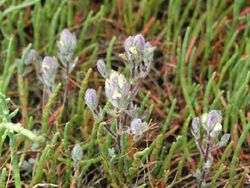Biology:Cordylanthus mollis
| Cordylanthus mollis | |
|---|---|

| |
| subsp. mollis | |
| Scientific classification Error creating thumbnail: Unable to save thumbnail to destination
| |
| Kingdom: | Plantae |
| Clade: | Tracheophytes |
| Clade: | Angiosperms |
| Clade: | Eudicots |
| Clade: | Asterids |
| Order: | Lamiales |
| Family: | Orobanchaceae |
| Genus: | Cordylanthus |
| Species: | C. mollis
|
| Binomial name | |
| Cordylanthus mollis A.Gray
| |
Cordylanthus mollis is a species of flowering plant in the family Orobanchaceae known by the common name soft bird's beak.
It is endemic to California , where it is known in coastal and inland salt marshes in the Central Valley, particularly the Sacramento-San Joaquin River Delta.
Subspecies
Both subspecies are rare, one treated as a federally listed endangered species. In general this is a grayish or purplish green annual coated in long whitish hairs, sometimes bristly and glandular. The woolly inflorescence is a spike of club-shaped white flowers enclosed in densely hairy sepals.
Subspecies Cordylanthus mollis ssp. hispidus, the hispid bird's beak, grows in alkaline and saline soils of marshes and playas in scattered locations throughout the Central Valley. Most of its habitat in the southern valley has been turned over for agriculture, leading to the extirpation of most of its populations there.[1] The even less common C. m ssp. mollis is known only from the coastal salt marshes and swamps of the inner Bay Area and Delta. It is federally listed as an endangered species.
Threats to the survival of this subspecies include the invasive marsh plant Spartina patens,[2] and destruction of its native habitat by erosion and drainage of the marshland.[3]
References
External links
Wikidata ☰ Q5170101 entry


